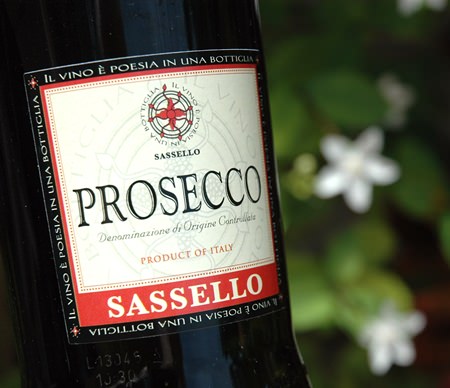I used to have a friend who claimed that given the chance, he would drink champagne with every meal. That always struck me as a bit over the top, because although Champagne makes a wonderful apéritif for sharpening the appetite, I wouldn’t want to slog through an entire bottle all the way through a meal. Even so, champagne matches a surprising number of different foods. In London, there’s a restaurant taking this theory to the limit by serving Champagne with hot dogs.
They evidently charge Bt. 300 for a hot dog and the same for a glass of champagne. Champagne connoisseurs would probably be horrified at the thought of matching fine wine with something as humble as a hot dog. It does seem to be verging on downright silliness, but presumably it brings the punters into the restaurant. In case you’re wondering, the restaurant is called “Bubbledogs”. It must have taken them ages to work out that name.

In Thailand, you can’t get a decent bottle of champagne for under about Bt. 3,000. I’m told that you can’t get decent hot dogs here either. If you want something with a bit of class like a Pol Roger or Piper-Heidsieck, we’re talking about Bt 4,000 baht and upwards for a bottle. Champagne is expensive partly because making the stuff is very labour-intensive. The secondary fermentation, which causes the bubbles to form, takes place in the bottle and various additional processes are necessary to ensure that the wine develops correctly. This takes time and time costs money.
If you enjoy sparklers, there are dozens of cheaper alternatives available. They’re cheaper than Champagne not because they are of inferior quality, but because they usually use a much more cost-effective method of production. Most of them use a process known as the Charmat method, in which the secondary fermentation takes place in stainless steel or glass tanks. Some cheaper sparklers are made in much the same way as sparkling soft drinks, in which carbon dioxide is injected into the wine. European wines made using this method are obliged to use the phrase “aerated sparkling wine” or “added carbon dioxide” on the labels.
One especially good alternative to Champagne is Italian Prosecco, which is not only the name of the wine but also the name of the grape from which it’s made. The wine comes from Italy’s Veneto region, up in the Northeast of the country. Prosecco is usually produced using the Charmat method, because the shorter tank fermentation preserves the freshness and the flavor of the grapes. Like other sparkling wines, Prosecco is always served very cold and tastes best when it’s young. So don’t keep a bottle for months in the vague hope that it will somehow improve. It won’t.
Oh, and another thing. I know I always drone on about pouring wines into a decanter or wine jug to get plenty of air into them. But never, ever do this with sparkling wines otherwise the characteristic bubbles that give the wine its character and charm will fade away rapidly. And that would never do. If you don’t manage to finish a bottle of sparkling wine at one session, it will usually keep the fridge for a short time if you can manage keep the air out. There’s no way you’ll get the cork back in again, because it expands so much when it’s taken out, but you can buy little plastic air-tight stoppers with a pull-down lever that effectively seal the bottle. I’ve found that sealing the bottle in this way keeps the wine fresh and the bubbles active for up to two days.
Sassello Prosecco Extra Dry (sparking white), Italy (Bt. 599 @ Tesco-Lotus, Villa and others)
This is a very pale straw colour, almost verging on colourless. There’s a good race of bubbles in the glass, especially if you use a proper champagne glass, called a Champagne flute, rather than an ordinary wine glass. This elegant narrow style of glass concentrates the aromas up at the top and lets the all-important bubbles show at their best.
The wine has a floral aroma of pears, apples and lychee. You’ll find that the wine is lovely and refreshing, with a delicate taste and plenty of fresh fruit on the palate. It has an attractive touch of crisp acidity too and a surprisingly long and fruity finish. It’s dry of course, but not in the tow-curling class. In the language of sparkling wine labels, “Extra Dry” means that the wine is only slightly dry. If you want a really bone-dry sparkler, you’ll need to look for one labelled “Extra Brut”.
At just 11% alcohol content it would make a brilliant apéritif but serve it as cold as you dare. Like Champagne, Prosecco is a very food-friendly wine and works well with a wide range of dishes. I noticed that the back label issues the stern warning “Do not shake”, advice presumably intended for Formula One racing drivers. In any case, sparkling wine bottles should always be opened gently, not with an unseemly and vulgar popping noise.
Mont Clair Sparkling Brut (white), South Africa (Bt. 379 @ various outlets)
Here’s a pleasant sparkler bottled at Siam Winery and a bargain price too. It’s a very light gold wine, with a plentiful supply of bubbles and a lovely fresh, fruity aroma of peaches and passion fruit. You may notice a dash of citrus and grassy herbs in the background too. Smooth, elegant and light-bodied, it has a dry and refreshing mouth-feel, plenty of fruit up-front and a dash of acidity that gives the taste an attractive bite. It has a long, dry finish with fruity and peppery overtones.
The wine originates in South Africa’s Breede River Valley and it’s blended in Thailand with a small quantity of local fruit wine. But don’t let that put you off because at just 12.5% alcohol content, it would make a lively pre-dinner drink, especially if you serve it really cold. I know this tends to subdue the aroma but the wine will soon warm up. Unlike most sparkling wines, this one comes with a very sensible plastic stopper, so if you don’t manage to finish the bottle, you can bash in the stopper and stick the bottle back in the fridge. This way the wine will keep its fizz for a couple of days.
This light-hearted easy-drinker would be terrific for any social event. Far be it from me to encourage dishonesty, but if you hide the label, some of your guests might think you’re serving champagne, unless of course you are keeping the wine to yourself. I think sparklers are invariably better on their own, enjoyed with lively conversation. But if you really want to serve it with food, this light zesty wine would go well with oysters or light desserts. Or even hot dogs, I suppose.




